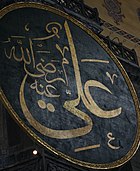
Back محمد بن الحنفية Arabic Məhəmməd ibn əl-Hənəfiyyə Azerbaijani محمد حنفیه AZB মুহাম্মদ ইবনে আল হানাফিয়াহ Bengali/Bangla Muhàmmad ibn al-Hanafiyya Catalan محەممەد کوڕی حەنەفی CKB Muhammad ibn al-Hanafīya German Mıhemmed bin Hanefiyye DIQ Muhammad ibn al-Hanafiyyah Spanish محمد حنفیه Persian
Muhammad ibn al-Hanafiyya | |
|---|---|
| 4th Kaysani Imam | |
| Preceded by | Husayn |
| Succeeded by | Abu Hashim |
| Personal life | |
| Born | c. 637–638 CE (16 AH) |
| Died | 700–701 CE Medina, Hejaz |
| Children | |
| Parents |
|
| Religious life | |
| Religion | Islam |
| Part of a series on |
| Ali |
|---|
 |
Muhammad ibn al-Hanafiyya (Arabic: مُحَمَّد ابْن الْحَنَفِيَّة, romanized: Muḥammad ibn al-Ḥanafiyya, c. 637–700, 15–81 AH) was a son of Ali ibn Abi Talib, who was the fourth caliph of islam (r. 656–661) Ibn al-Hanafiyya was an effective lieutenant for his father Ali during his caliphate. After the assassination of Ali and the deaths of his two sons Hasan and Husayn, many recognized Ibn al-Hanafiyya as the head of the House of Ali. Claiming to represent Ibn al-Hanafiyya, Mukhtar al-Thaqafi rose in Iraq in 686 to avenge Husayn and his relatives, who were massacred in 680 CE by forces of the Umayyad caliph Yazid bin Mu'awiya (r. 680–683). The quiescent Ibn al-Hanafiyya did not actively associate with this rebellion but was still rescued by Mukhtar when he was detained by the rival caliph Ubayd Allah ibn Ziyad. Support for Ibn al-Hanafiyya continued even after the defeat and death of Mukhtar in 686–687 in the form of the Kaysanites, a now-extinct Shia sect that traced the imamate to Ibn al-Hanafiyya and his descendants, particularly his son Abu Hashim. After the death of Ibn al-Hanafiyya in 700–701, some Kaysanites declared that he was the Mahdi, the eschatological Islamic leader who would reappear in the end of time and eradicate injustice and evil. The Kaysanites later provided the organizational structure for the Abbasids to overthrew the Umayyads in 750–751.